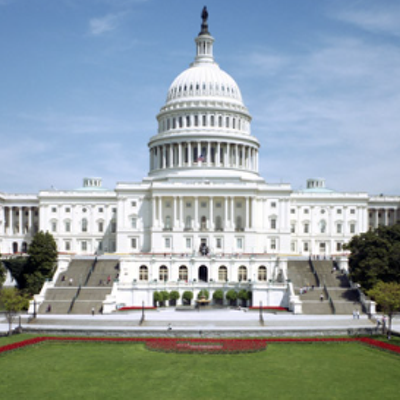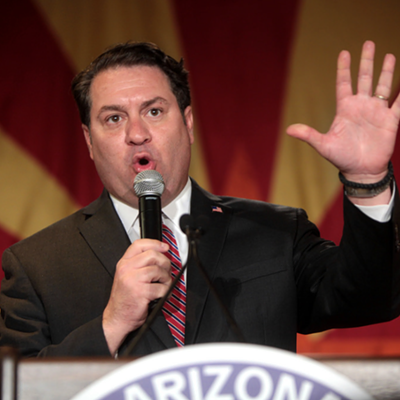SICK SPENDING
U.S. Sen. Jon Kyl stopped by Arizona Illustrated last week—not to gloat about the GOP's big takeover of the House of Representatives, but to tamp down expectations by reminding viewers that Republicans won't control the U.S. Senate or the presidency. Kyl's spin: Don't expect too much from the GOP until voters give them back the Senate and the presidency.
But Kyl's response to a question about Medicare funding left us wondering just how committed the GOP really is to balancing the budget.
One of the GOP's biggest attack lines during the recently completed campaign season was that Democrats had cut $500 billion from Medicare as part of the health-care reform package. It was one of the lines we heard over and over again from Republican Jesse Kelly in his campaign to unseat Democratic Congresswoman Gabrielle Giffords (which always struck us as odd, given that Kelly's own long-term proposal was to get rid of Medicare and ask elderly Americans to buy health insurance in a private market so they would be able to "get off the public dole").
As any fact-check site will tell you, Democrats didn't actually cut $500 billion from Medicare; they reduced future expected expenditures over the next decade by $500 billion with a few reforms.
Whether those reforms will actually take place remains to be seen; some of them involve reducing payments to doctors and hospitals—a touchy move that's been tried before, yet has always been reversed by Congress before it actually takes place.
But one big cost reduction—an estimated $136 million over 10 years, according to The New York Times—came by reducing the amount of money the federal government would spend on the Medicare Advantage program, an alternative to traditional Medicare that pays private insurance companies to provide coverage for elderly Americans.
The original idea behind Medicare Advantage was an admirable experiment: Let's see if private insurers could provide better health-care coverage to seniors at a lower cost than the government could through traditional Medicare.
Unfortunately, it turned out that, while popular (about one-fourth of all Medicare recipients are on Medicare Advantage), Medicare Advantage was not cheaper. It actually cost taxpayers about 14 percent more than traditional Medicare. That totaled an estimated $44 billion between 2004 and 2008, according to the Medicare Payment Advisory Commission.
The Democratic health-care reform plan works to rein in the future growth of spending for those plans by giving the government more leverage over the private insurers. And in the short run, it worked; the Times reported earlier this year that many insurance companies actually dropped the cost of premiums for Medicare Advantage patients rather than lose the business altogether.
But instead of applauding this example of market forces in action, Kyl says the reductions were a big mistake, arguing that "people who didn't like the private-sector alternative were trying to make it less attractive."
Kyl says he also opposes cuts in payments to doctors if that results in "rationing care," but assured viewers that there were "other places in Medicare where cuts can occur." Of course, he didn't name any of these "other places."
If you're going to keep shoveling money to private insurers, and you're not going to limit what doctors can charge, we find it pretty hard to believe that you're serious about reducing the cost of Medicare. And if you're not serious about that (and if, like Kyl, you're also opposed to any tax increases on anyone), then it's pretty hard to believe that you're really serious about reducing the deficit.
BUS TICKET TO TROUBLETOWN
Tucson City Council members have a new problem on their hands: What should they do about the Greyhound Bus terminal?
Greyhound used to be located next door to downtown's Rialto Theatre, but that was a lousy location for a variety of reasons—not the least of which was that there are better uses for that property, which is now scheduled to be developed as part of Jim Campbell's proposed housing and retail development.
The city moved Greyhound from that site to a temporary location next to Interstate 10. Now, City Manager Mike Letcher wants to sell that parcel, which at one point was going to be the location of a new arena. (As you might have noticed, it's unlikely the city will be building a new arena anytime soon.)
So city staff has gone back to the City Council's original direction, which was to put the bus station at Sixth and Toole avenues.
The idea, back then, was to create a big transit hub that included local buses, Greyhound buses and Amtrak trains all coming together. (We'll leave aside the central problem with that notion, which is that the Amtrak trains only roll through town three times a week, late at night, which doesn't exactly create the bustling atmosphere of Grand Central Station.)
Today, the city is so broke that it can't afford the $18 million that it would take to build a new bus station, which was supposed to have office space above it. Instead, transportation and real-estate officials are proposing to include the bus station at the northwest end of the train station and install some bus bays on the vacant lot next door to the station.
This, naturally, has folks like Hotel Congress owner Richard Oseran upset, because he's invested a considerable amount of money in getting Maynards Market and Kitchen up and running at the other end of the train station.
"Whatever arguments you could have made for putting the bus station downtown six or seven years ago, there's been a dramatic change in the last six or seven years," Oseran says. "It's now an entertainment district. ... We're trying to create commercial activity and residential spaces. Here you have the last piece of dirt in the district that could be developed for that purpose, and you'd be putting bus bays on it."
Ward 6 Councilman Steve Kozachik doesn't mince any words about the proposal, saying that it sounds like "one of the dumber ideas that's come down to us."
Koz says the plan will increase traffic in "an already congested area that's finally starting to see some private-sector development ... I hardly think it's the highest and best use for that area. Wrong place, wrong time, wrong activity."
There's one problem with not moving the bus station over to the train depot: The city got a big grant from the Federal Transit Administration based on plans to have a multi-modal transportation hub. So there's $2 million out there that can be used to cover the expense of moving Greyhound if it ends up near the train depot.
Ward 1 Councilwoman Regina Romero says she's keeping an open mind about the proposal, but is concerned about giving up the federal funds.
"Are we going to lose almost $2 million if we choose another space?" Romero asks. "That's a very important piece of the puzzle."
Transportation Director Jim Glock says the $2 million doesn't have to be spent on the bus station. He says the money could go toward more improvements of the train depot.
The council is set to discuss the Greyhound Bus proposal during its weekly study session on Tuesday, Nov. 23.
Follow the Skinny scribe on Twitter: @nintzel







